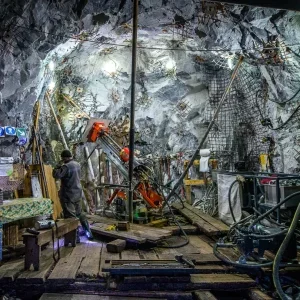
As automation becomes increasingly integrated into mining operations, the need for a network with the bandwidth and capacity to handle high processing speeds has grown along with it. As a result, miners are looking to 5G to address this issue. Andrew Barnett asks Morgan Rody, senior project manager for automation and interoperability at Epiroc’s technology and digital division, and Robert Le Busque, vice-president for Verizon Asia-Pacific, about the benefits of 5G integration with regards to enhancing automation and safety.
Everyday users of mobile phones aren’t the only ones awaiting the much-hyped arrival of universal fifth-generation (5G) mobile networks. The mining industry also sees an exciting opportunity for evolution as it continues to invest in new technologies, with high speeds and real-time connectivity opening the door to a revolution underground.
One major player facilitating the introduction of 5G is Verizon. Robert Le Busque, vice-president for the company’s Asia-Pacific operations, says the technology offers miners a unique and valuable opportunity to drive the sector towards a digital transformation, especially in core markets such as Australia.
“We know that Australia’s mining industry plays a huge role in the country’s economy. The mining sector is a perfect example of how new technologies, such as private 5G, can transform an entire industry and keep Australia at the global forefront.”
Le Busque says 5G has the potential to deliver the high-speed connections needed to support a wide range of new applications that require more performance than 4G can deliver.
“Over 4G Long Term Evolution (LTE), network latency – the time it takes for a data packet to make a round trip between two points – was cut in half from 3G, with response times from 15ms to 60ms versus 120ms. That remains the industry benchmark. But over a 5G network, latency could drop to 10ms, making lag times nearly undetectable.”
Combine this speed with scale and automation, and the technology comes into its own: 5G can support up to one million devices per square kilometre. These capabilities were unthinkable in a 4G world. “The shift from 4G to 5G is massive,” Le Busque says.
5G and automation could revolutionise mining
Morgan Rody is the senior project manager for automation and interoperability at the technology and digital division of equipment and infrastructure specialists Epiroc. He says 5G could revolutionise mining on a number of fronts, including accelerating ongoing efforts to implement automation.
“Fewer human workers underground always equals increased safety. As autonomy gains traction and proves to safely increase production, we will see fewer human workers in the underground environments and this will be a direct result of
the inclusion of 5G,” says Rody.
“This is not to say autonomy can’t happen without 5G, but for it to happen at scale, there needs to be more bandwidth available with increased reliability. A handful of machines can be successfully autonomous today using 4G or Wi-Fi, but if we are to increase that to a fleet of 20, 50 or more machines, 5G will be a vital component in that journey.”
Rody notes that the technology will also enable control rooms to move above ground. “Again, this is already happening today, but larger and more centralised control rooms – perhaps connected to and controlling a number of mine production sites globally – will become the new normal.”
Le Busque says 5G is the ideal technology to drive automation forward. “In its most basic sense, a simple boost in wireless speed and bandwidth improves responsiveness,” he explains. “Many machine-focused applications require a high level of integration
and interaction between individual devices and controllers or servers.”
The amount of data that must be transferred and aggregated to support real-time machine applications – such as industrial automation and autonomous vehicles – is enormous. As these application ecosystems evolve, it is likely that they will become even more hungry for bandwidth to deliver improved business outcomes.
Rody also flags the arrival of large-scale audio-visual technology. HD video, for example, could be transmitted from mining machines to control rooms with zero lag.
“By creating communication ‘lanes’ you can split video, telematics data, near real-time data and command critical data, creating an efficient network where the ‘lanes’ cannot interfere with one another,” he says.
This increased visibility and separation will further enhance safe and successful automation.
Le Busque points out that there are also significant benefits in terms of security. “5G itself doesn’t introduce new risks; it is simply a means of transporting internet protocol (IP) traffic,” he says. “One of the big differences with 5G is that a lot of the learnings from 3G and 4G when it came to security have been embedded into 5G architecture.”
The standard – created by the 3rd Generation Partnership Project (3GPP) – is centred on security. New capabilities and architecture concepts have been built into 3GPP and subsequently used for 5G to help safeguard network transport.
5G also enables Zero Trust, a concept that ensures no component of the network can execute an action or transmit data to another entity without authentication
and authorisation.
“Additionally, 5G incorporates comprehensive encryption standards and encryption methodologies, so data is secured and encrypted in transit,” says Le Busque.
Companies will also be able to use 5G to improve efficiencies. Le Busque says real-time data will be more readily available via mobile apps to facilitate predictive maintenance and cut equipment downtime. Improved connectivity and better data processing power across more devices will pave the way for more responsive supply chains that have greater visibility of production.
Helping companies reduce their carbon footprint is another positive benefit. “Mining sites can manage energy and control emissions by monitoring heating, ventilation and air-conditioning (HVAC) and lighting systems, reduce unnecessary use and provide timely maintenance,” says Le Busque.

Local and national authorities will need to work together to ensure even coverage
Rody says some mining operators will be better placed to benefit from 5G technology than others, given the variance in local infrastructure standards. Cooperation and collaboration between the industry, governments and telecoms companies at a local level will be vital to a successful rollout.
“Any wireless network requires a number of access points or towers – or a mixture of both – and these need to be placed throughout the target environment so they offer the best coverage,” he says.
“We are seeing that the host country can provide the 5G network to the mine site and then it is up to the mine to supply the remaining infrastructure. So here we see a mix of host country public and private mine infrastructures working together. This is quite new in the mining industry and more telecoms operators are starting to see the opportunities here. Their participation in this is important.”
Le Busque agrees that this local buy-in is crucial and says policy is now keeping pace with innovation, with governments providing incentives for system integrators and solution providers to invest in the technology.
He cites 5G innovation grants in Singapore and the allocation of private 5G spectrum in Australia, Germany, the UK and Japan as examples of how governments, regulators and industry are working together.
Support has been particularly strong in Australia, a key market for Verizon and a global mining powerhouse. “The Australian Communications and Media Authority (ACMA) is facilitating a variety of licence types in the 26GHz and 28GHz bands (mmWave) for the deployment of 5G technology,” says Le Busque.
“The regulator also plans to include area-wide apparatus licences (AWLs), class licences for low-power devices and spectrum licensing in the 26GHz band to cater to the deployment of dense networks in areas that are highly populated.”
It’s envisaged mmWave in the 26GHz and 28GHz bands will support a wide range of 5G uses across the transport, health and education sectors in addition to advanced manufacturing and mining. It will also be used for wireless broadband, satellite communications and the internet of things.
The rollout is ongoing but challenges remain
Since October 2020, Verizon has been working on an international private 5G business platform for Europe and Asia-Pacific. The launch project – in partnership with Nokia – promised businesses a private industrial grade dedicated 5G network capability on their own premises.
Each private network would be self-contained and house its own components – including micro-towers and small cells – on site. It would connect to a local area network (LAN) and other applications. It’s this type of setup that miners are looking to exploit. Currently testing is being done on 4G LTE hardware and networks.
“How that will differ from the final 5G infrastructure is not yet finalised and this is something that is evolving as the testing progresses,” says Rody.
While trials have been under way at various sites worldwide for a number of years, the actual pace of change has been slow. “This is normal in the mining industry – fast adoption of any new technology is not what the mining industry is known for,” Rody says.
“We see the main push coming from global players that have high ambitions for mining automation and have already trialled automation solutions for a decade or longer. In the past two years, interest in 5G technology has increased and there are more trials planned in 2021 and 2022. I think a wider uptake will be in direct connection to a mine’s autonomous ambitions.”
However, hurdles to the large-scale integration of 5G remain. Rody says that in addition to winning backing from telecoms operators at a national level, there’s a need to build up the right competencies in terms of using and understanding the technology.
“Although there are some similarities between a Wi-Fi network and a cellular network, there are still a great deal of new configurations available and here there is a
clear knowledge gap,” he says.
“Getting telecoms operators and mines talking together in the ‘same language’ is also an issue we face and here a lot of patience is required on both sides. A great deal of this is still new territory, but together we are taking huge steps forward towards a joint 5G future, which will help deliver safer mining sites with large scale autonomous fleets producing more ore than ever before.”
This article first appeared in World Mining Frontiers magazine, Vol. 1 2021.






